October 01, 2005
When we dream, do we dream we're Joey?
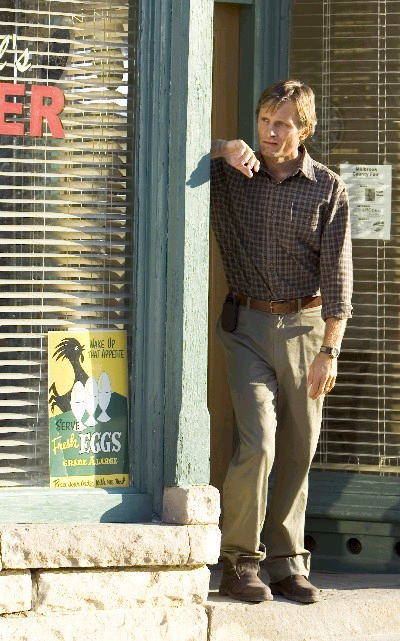
'When you dream, do you dream you're Joey'? - Carl Fogarty to Tom Stall, in A History of Violence
'In a dream he is a butterfly. ... When Choang-tsu wakes up, he may ask himself whether it is not the butterfly who dreams that he is Choang-tsu. Indeed he is right, and doubly so, first because it proves he is not mad, he does not regard himself as fully identical with Choang-tsu and, secondly, because he doesn't fully understand how right he is. In fact, it is when he was the butterfly that he apprehended one of the roots of his identity - that he was, and is, in his essence, that butterfly who paints himself with his own colours - and it is because of this that, in the last resort, he is Choang-tsu.' - Lacan, 'The Split Between the Eye and the Gaze', The Four Fundamental Concepts of Psychoanalysis
The key scene in Cronenberg's A History of Violence sees the local sheriff addressing the hero, Tom Stall (Viggo Mortensen), after a series of violent killings have disrupted the life of the small midwest town in which they both live: 'It just doesn't all add up.'
Superficially, A History of Violence is Cronenberg's most accessible film since 1983's The Dead Zone. Yet it is a film whose surface plausiblity doesn't quite cohere. All the pieces are there but, when you look closely, they can't be made to fit together. Something sticks out....
What makes A History of Violence unsettling to the last is its uneasy relationship to genre: is it a thriller, a family drama, a bleak comedy, or a trans-generic allegory ('the Bush administration's foreign policy based upon a western')? This generic hesitation means that it is a film suffused with the uncanny. Even when the standard motions of the thriller or the family drama are gone through, there is something awry, so that A History of Violence views like like a thriller assembled by a psychotic, someone who has learned the conventions of the genre off by heart but who can't make them work. Perversely, but appropriately for a Cronenberg picture, it is this 'not quite working' that makes the film so gripping.
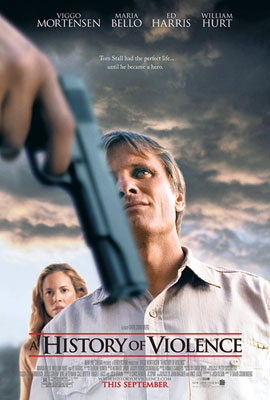
The near total absence of the prosthetics and FX for which Cronenberg is renowned from A History of Violence (traces of his old schtick survive only in the excessive shots of corpses after they have been shot in the face) has been remarked upon by most critics. In fact, Cronenberg's renunciation of such imagery has been a gradual process, dating back at least as far as Crash (1998's Existenz may turn out to be the last hurrah for Cronenberg's pulsating, eroticized bio-machinery), but it has subtlized, rather than removed, his trademark ontological queasiness.
Myth is everywhere in A History of Violence: not only in the hoaky small-town normality which is threatened, nor in the urban underworld of organized crime that threatens to encroach upon it and destroy it, but also in the conflict between the two. A town like Millbrook, the Indiana setting for A History of Violence, has been as likely to feature in American cinema as an image of menaced innocence in its own right. Comparisons with Lynch are inevitable, but it is Hitchcock, not Lynch, who is the most compelling parallel. The Hitchcock comparison goes far beyond surface details, significant as they are, such at the fact that, as the Guardian review reminds us, A History of Violence's 'Main Street resembles the one in Phoenix, Arizona, where the real estate office is to be found in Psycho'. There is a much deeper affinity between A History of Violence and Hitchcock which can be readily identified when we recall Zizek's classic analysis of Hitchcock's methodology. In Looking Awry, Zizek compares Hitchcock's 'phallic' montage with the 'anal' montage of conventional cinema.
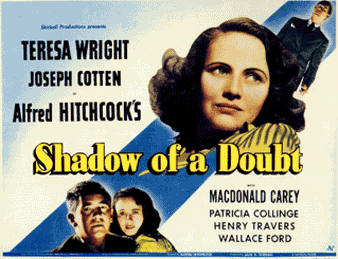
'Let us take, for example, a scene depicting the isolated home of a rich family encircled by a gang of robbers threatening to attack it; the scene gains enormously in effectiveness if we contrast the idyllic everyday life within the house with the threatening preparations of the criminals outside: if we show in alternation the happy family at dinner, the boisterousness of the children, father's benevolent reprimands, etc., and the "sadistic" smile of a robber, another checking his knife or gun, a third grasping the house's balustrade.
In what would the passage to the "phallic" stage consist? In other words, how would Hitchcock shoot the same scene? The first thing to remark is that the content of this scene does not lend itself to Hitchcockian suspense insofar as it rests upon a simple counterpoint of idyllic interior and threatening exterior. We should therefore transpose this "flat", horizontal doubling of the action onto a vertical level: the menacing horror should be placed outside, next to the idyllic interior but well within it: under it, as its "repressed" underside. Let us imagine, for example, the same happy family dinner shown from the point of view of a rich uncle, their invited guest. In the midst of the dinner, the guest (and together with him ourselves, the public) suddenly "sees too much," observes what he was not supposed to notice, some incongruous detail arousing in him the suspicion that the hosts plan to poison him in order to inherit his fortune. Such a "surplus knowledge" has so to speak an abyssal effect ... the action is in a way redoubled in itself, endlessly reflected as in a double mirror play... things appear in a totally different light, though they stay the same.' (89-90)
What is fascinating about A History of Violence is that it recapitulates this passage from the anal to the phallic within its own narrative development, entirely appropriate for a film that shows, as Graham Fuller puts it, 'the return of the phallus'. It begins, precisely, with a non-Hitchcockian contrast between a threatening Outside (a long, sultry tracking shot of two killers leaving a motel) and an idyllic Inside (the Stalls' family house, where the six-year old daughter is comforted by her parents and her brother after she is woken from a nightmare). But as the film develops, it effectively re-topologizes itself, interiorizing the Threat, or, more accurately, showing that the Outside has always been Inside.
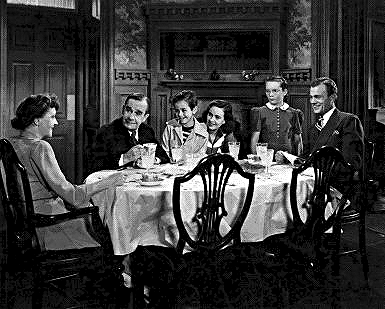
The Hitchcockian blot, the Thing that doesn't fit, is the 'hero' himself. The film's central enigma - is the staid, pacific Tom Stall really the psychopathic assassin Joey Cusack? - can be resolved into the question: which Hitchcock film we are watching? Is A History of Violence a rehashing of The Wrong Man or Shadow of a Doubt? Disturbingly, it turns out that it is both at the same time.
Shadow of a Doubt is the working out of a family scene much like the one described by Zizek above, although in that case, it is the guest, the rich uncle, who is the threat to the domestic idyll. The uncle (Joseph Cotten) is a killer of rich widows who has holed up in the house of his sister's family to hide from the police. The Wrong Man, meanwhile, sees a family destroyed when the father is falsely accused.
In Shadow of a Doubt, the uncle's malevolence means that he must die so that the family idyll can be preserved. Only the Teresa Wright character knows the truth; the rest of the family, and the big Other of the community, are kept in ignorance. But of the family members in A History of Violence, by the end of the film, only the youngest child could plausibly not be aware that the family scene has always been a simulation. Crucial in this respect is the response of Stall's wife, Edie (Maria Bello), as Ballard observed in his piece on A History of Violence in the Guardian:
'A dark pit has opened in the floor of the living room, and she can see the appetite for cruelty and murder that underpins the foundations of her domestic life. Her husband's loving embraces hide brutal reflexes honed by aeons of archaic violence. This is a nightmare replay of The Desperate Hours, where escaping convicts seize a middle-class family in their sedate suburban home - but with the difference that the family must accept that their previous picture of their docile lives was a complete illusion. Now they know the truth and realise who they really are.'
But this isn't so much a matter of accepting reality in the raw, as it were, but, very much to the contrary, it is a question of accepting that the only liveable reality is a simulation. Where at the start of the film, Edie play acts the role of a cheerleader for Tom's sexual delectation, by the end she is playacting for real. (And of course, of course.... there are no authentic cheerleaders, 'real' cheerleaders are themselves playing a role.) If, as Zizek argued in Welcome to the Desert of the Real, 9/11 was already a recapitulation of the 'ultimate American paranoiac fantasy ... of an individual living in a small idyllic ... city, a consumerist paradise, who suddenly starts to suspect that the world he lives in is a fake', a kind of real life staging of The Matrix, then A History of Violence may be the first post 9/11 film in which the American idyll is deliberately and knowingly re-constructed AS simulation. (This is underscored by the fact that not one frame of the film was shot in America. In this respect, the film resembles Kubrick's Lolita, whose America of motels and dusty highways was entirely reconstructed in Britain. In his interview with Salon.com, Cronenberg pronounced himself proud of his ability to hoodwink American audiences into believing that they were really seeing the midwest and Philadelphia.)
'When you dream, do you dream you're Joey?' the mobster Fogarty (Ed Harris) asks Tom Stall, perhaps deliberately echoing Chuang Tzu's story of a man who dreamt he was a butterfly. Chuang Tzu famously no longer knows if he is a butterfly dreaming that he was Chuang Tzu or Chuang Tzu dreaming that he is a butterfly. Is Tom Stall the dream of Joey Cusack, or is Joey Cusack the bad dream of Tom Stall? It's no surprise that Lacan should have fixed upon this story, and Forgarty's question contains an analyst's assumption: the reality of Tom lies not at the level of the everyday-empirical but at the level of desire. The Real of Stall/Cusack is to be found, fittingly, in the desert, the space of subjective destitution where Stall says that he 'killed Joey'.
In an interesting but ultimately unconvincing piece in Sight and Sound, Graham Fuller argues that we should read the film as Stall's fantasy:
'"Who is Joey Cusack?" the movie ponders at its midpoint as it leaves Western territory behind and plunges into a dark pool of noir. But the more fruitful question is "Who is Tom Stall, if not whom Fogarty claims he is, and why does he have a superegoic alter ego?" The name "Stall" indicates stasis. Though he is a diligent, caring husband and father, Tom knows he hasn't made much of himself in life, and, we learn, harbours resentment towards his estranged wealthy brother, who considers him a fool. This chip on Tom's shoulder explains his daydreaming which, born of repression, aligns him which such literary and movie dreamers as Walter Mitty and Billy Liar, whose fantasies of themselves as all-conquering heroes are redolent of crippling neuroses, even impotence...'

Tempting as it is, this interpretation is unsatisfactory for a number of reasons. It is guilty of the same 'oneiric derealization' which has blighted responses to both Lynch's Mulholland Drive and Kubricks's Eyes Wide Shut, both of which have been interpreted as long dream sequences. Such readings ultimately amount to an attempt to put to rest the films' ontological threat, ironing out all their anomalies by attributing them to an interiorized delirium. The problem is that this denies both the libidinal reality of dreams - we wake ourselves from dreams, Lacan suggests, in order to flee the Real of our desires - at the same time as it ignores the way in which ordinary, everyday reality is dependent for its consistency on fantasy. It also makes the empiricist presupposition that the quotidian and the banal have more reality than violence; the message of the film is rather that the two are inextricable.
In the end, Stall as the fantasy of Cusack is much more interesting than Cusack as the fantasy of Stall. Is the American small-town idyll the fantasy of a psychopath? After Guantanamo Bay, after Abu Graib, this question has a special piquancy. The challenge that A History of Violence poses to the audience comes from the fact that we fully identify with Stall/ Joey's violence. We gain enormous enjoyment when the hoods are dispatched with maximum efficiency. When we dream, do we dream we're Joey? Do we dream as Joey? Do we dream of being Tom, innocent, regular people, no blood on our hands? Are our 'real', everyday lives really only this dream?
At the same time as we enjoy Joey's hyperviolent killing of the gangsters, we know that it is impossible for us to position them as the Outside and Stall/ Joey as the Inside, and the film reinforces the lesson that Zizek thought we should have learned in the aftermath of 9/11. 'Whenever we encounter such a purely evil Outside, we should gather the courage to endorse the Hegelian lesson: in this pure Outside, we should recognize the distilled version of our own essence. For the last five centuries, the (relative) prosperity and peace of the "civilized" West was bought by the export of ruthless violence and destruction into the "barbarian" Outside: the long story from the conquest of America to the slaughter in Congo.'
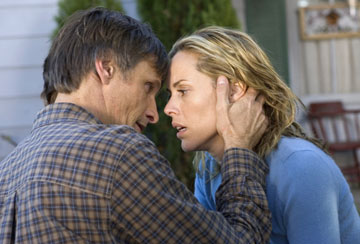
The most disturbing aspect about the film's violence is not the gore that results from it, but the reptilian mechanism of its execution. There are no wisecracking one-liners; instead, once the killings are completed with a coiled spring autonomic power, there is an entranced animal calm, a machine exhaustion. (A History of Violence is reflexive without ironic, entirely lacking in any PoMo swagger. It may have put the final bullet into Tarantino's career, if the spectacular indulgence of Kill Bill didn't already do that.)
A History of Violence suggests that 21C America is a less a country in which violence is a repressed underside than that it is moebian band where if you begin with ultraviolence you will eventually end up with homely banality, and vice versa. In the final scene, when Tom - now 'Tom' - returns to his house, 'everything appears in a totally different light, though it has stayed the same'. The images of domesticity have now become 'images of domesticity', the meat loaf and the mashed potato have become 'meat loaf' and 'mashed potato', reflexively-placed icons of American normality, the very defintion of the unhomely, the unheimlich, the uncanny. Such, as Zizek said in the 9/11 piece, is the nature of 'late capitalist consumerist society' where '"real social life" itself somehow acquires the features of a staged fake'. This is a simulated scenario far bleaker than that of The Truman Show or Dick's 'Time Out of Joint', since it has been freely and knowingly embraced by the subjects themselves. There is no Them behind the scenes orchestrating and choreographing the simulation. At the end of the film, everyone is fooling but no-one is fooled.
Posted by mark at October 1, 2005 12:39 PM | TrackBack